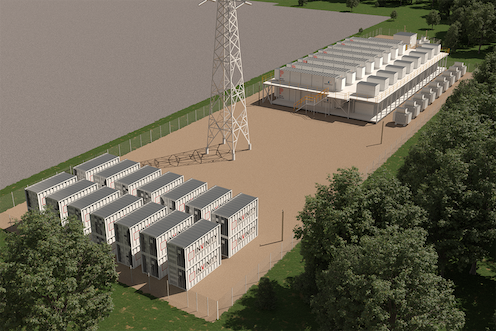
Anthony Price OBE, Managing Director at UK-based specialist energy storage consultancy group Swanbarton, has dedicated over twenty-five years to developing, commercialising and promoting energy storage technologies to help deliver clean, secure and affordable energy in the UK and beyond. He’s also one of the organisers of the annual International Flow Battery Forum and here discusses what was talked about at this year’s event — and how that fits in with the scaling up of energy storage we see around the world.
Enjoy 12 months of exclusive analysis
- Regular insight and analysis of the industry’s biggest developments
- In-depth interviews with the industry’s leading figures
- Annual digital subscription to the PV Tech Power journal
- Discounts on Solar Media’s portfolio of events, in-person and virtual
Big energy storage is in the news: about a dozen miles from our offices, near to the small village of Minety in the UK, renewable energy and storage company Penso Power has just brought its 100MW / 100MWh battery project online. Meanwhile, in Coventry, about 70 miles north, plans are being made for a factory to produce 60GWh of lithium-ion batteries each year to serve the growing demands for electric vehicles.
Worldwide, 230 GW of wind and solar power generation was added in 2020. Almost daily there are news items either about battery production and battery use, or about the need for energy storage to support the introduction of renewable energy or to help decarbonise our power supplies.
But it’s not only big energy storage that will create headlines. Going forwards, the case for longer duration storage is also a high priority.
We learnt and discussed some important things about flow batteries and energy storage at this year’s edition of the International Flow Battery Forum symposium:
- There is no universal solution to the challenge of energy storage. Of course, we all know that, but it’s a useful reminder that there are many alternative solutions. As with so many different applications and requirements one size, shape or flavour does not fit all.
- Big storage and long-duration storage are the requirements of the future. As we write this, BEIS (the UK government’s Department for Business, Energy and Industrial Strategy) is awaiting responses to its call for projects in the Long Duration Energy Storage competition. Georgina Morris, Programme Manager of the Department’s Smart Energy Team, told us about their 10 point plan and the importance of long-duration storage to support the route to reach net zero. With increased lobbying from many quarters, BEIS is promoting the strategic importance of having a diversified approach to energy storage.
- The European Commission is listening: Johan Blondelle of the Commission’s Directorate-General (DG) for Research and Innovation said, “Flow batteries form a sweet spot between lithium-ion and hydrogen to provide large-scale and affordable storage.” Although lithium-ion is attractive, not least for its use in EVs, other storage solutions are needed. Gonzalo Fernandez-Costa, a policy officer with the commission’s Directorate General for Energy, confirmed that the European Commission is open minded in its approach to storage technologies and will be consulting on its policy during this coming autumn.
- The State of California is taking action. The energy needs for California have been well documented over many years – their duck curve was a very familiar example of why energy storage was a necessity in the state. Other states in the USA and other countries are watching developments with interest. Mike Gravely, Research Programme Manager at the California Energy Commission, gave his perspective on the programme to kick start a massive investment in energy storage to manage the generation supply curve.
- Flow battery technology can deliver products with good performance and capability, but the industry needs to tell this to its potential customers. One flow battery user, Max Urban of NOe Netz (an Austrian power company), reported on 10 years’ operation of their vanadium flow battery and the news that over its lifetime it had only suffered a 1% drop in energy storage capacity.

It’s easy for technology developers and manufacturers to make claims and counter claims about their own products and those of competing systems. Safety, reliability, low degradation and recyclability are recurring themes when positioning new products in the market. But this year there was a real sense that the flow battery industry has reached a point of maturity – companies such as Invinity, Cellcube, Redflow, Visblue, Elestor and Volterion have all made great progress in bringing products to market and securing sales.
Invinity have installed a flow battery to work in hybrid mode with a conventional battery system at the Oxford Super Hub, and Invinity are also supplying their flow battery to support a tidal energy project in the Orkney Isles. The other flow battery companies are also proud members of the “100 flow battery club” – 100 new installations in operation around the world. There is space to grow the market and new technologies are stepping forward and taking a leading role. For example, Kemiwatt, one of the organic flow battery manufacturers, has completed its first deployment and demonstration of their flow battery system – with tests passed with flying colours.
Battery energy storage has had a magnificent time over the past five years – the number and size of battery installations has increased, both in front-of-the-meter and in behind-the-meter applications. Our discussions at the IFBF showed that now is a good time to think a little more about the strategy for storage – to consider the supply of raw materials, manufacturing costs and embedded carbon and energy, recyclability and re-use, as well as safety and operational performance.
To reach net zero, we will be switching as much as we can from fossil fuels to renewables and the electricity vector. That’s going to need more storage – for both stationary and mobile applications. The car industry will probably need to spend billions of dollars on conventional battery gigafactories to power its new EV’s but the energy industry can save billions by investing in flow battery manufacturing to meet at least part of the requirement for stationary storage.
It’s going to need persuasive talk with the finance sector to gain investment in manufacturing, and a fresh approach by customers and end users of storage when they select the battery and energy storage technologies of the future.
The change is already happening – Patricia Scroggin-Wicker, a project manager with Burns McDonnell, an engineering company in the USA, pointed out that clients are now asking about longer duration storage, demanding higher performance and lower costs, making the clear case for energy storage systems with a low incremental cost of additional energy storage capacity.
Manufacturer VRB Energy is starting construction of a large scale 100MW / 500MWh vanadium flow battery project in Xiangyang, Hubei Province, China, this summer. That’s five times larger than the Minety battery — which is currently the biggest grid-connected battery system in Europe, by the way. The switch to flow is happening. Who’s next?

